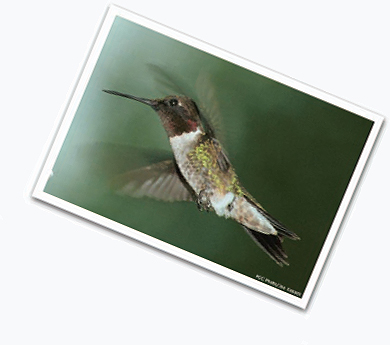FIELD NOTES: Feast of the Hummers
by Charles Bier

As I start out on the trail, I remind myself, “Remember to be observant.” I know this is good advice, as it has resulted in some great experiences in the past — such as one humid, hazy July afternoon last summer.
I had parked on a remote road that runs along the spine of Chestnut Ridge in southern Fayette County. Having walked a half-mile to explore the forest for special habitats (none found), I cut back toward the road leading to the car and waded through some vegetation.
Pushing through the waist-high plants, I noticed that it was an almost pure colony of poke milkweed. I had never encountered hundreds of this plant before, and in their full bloom they imparted a light perfume to the heavy air. As I reached the edge of the road, I caught a flutter of motion from the corner of my eye. “Oh, a hummingbird,” I thought, and as I turned up the road, I craned my neck to be a little more observant at the same time. That first step up the road was also my last for the next 20 minutes, for looking back at the milkweed I found numerous tiny greenish apparitions swirling around the flowers. Sure, I had seen plenty of ruby-throated hummingbirds before, but immediately I was transfixed by the number of hummers in one place! I froze and panned across the milkweed patch, trying to count. With their rapid movements in and around the plants, I could only guess; there were 10, 12 or 15, at least. As I gave up on an exact number it dawned on me, “I am witnessing a hummingbird feast!”
I lowered my gaze to the closest hummer with its shimmering green back, nearly within my grasp. Zip. It was soon displaced by another, and then that one quickly zipped a short distance to bump a bumblebee trying to compete for the milkweed nectar. The sounds of ultra-high twitters and vibrating wings accompanied each bird in motion. Clearly, they had personal space and kept pushing each other away from the sweetest flowers.
One of the feeding birds then gave me a botany lesson: Milkweed flowers have five petals, each with its own nectary. Subsequently, I watched each bird hover below the drooping inflorescence of a few dozen flowers and probe each individual flower five times with its bill, up and down, with one upside-down sewing-machine motion for each tube-like nectary; one sip for each, five sips per flower, but only a few flowers visited in any one flower cluster before — zip! — another hummer zoomed in to push away the meal-taker.
With their faded white throats, I could tell most of the hummingbirds were females — probably with hungry nestlings in the distance. The sun was over my left shoulder as yet another hummingbird parked at one of the flower clusters and began to feed. The black throat on this bird told me it was a male (their colors are created by the reflection of light). As he fed and rotated around the flowers, the point of reflection arrived and in an instant his black throat burst into a blaze of glistening rubies. Wow.
Every time I see these flying bundles of energy I wonder how they can take in enough calories to support their frenetic behavior. (Hummingbirds’ wings beat 50 to 80 times per second compared to five to 20 seconds for many birds). I saw this day that the hummers worry about this, too, as demonstrated by a couple of individuals who found it convenient to sit on a leaf while feeding.
Finally, I had to go, and returned to my car with visions of the hummingbird feast buzzing in my head and the well-used advice of “be observant” ringing in my ears.
P.S. Later I found out that the collective noun for a group of hummingbirds is a “charm” — which sounds appropriate.
Charles Bier is senior conservation scientist for the Western Pennsylvania Conservancy
